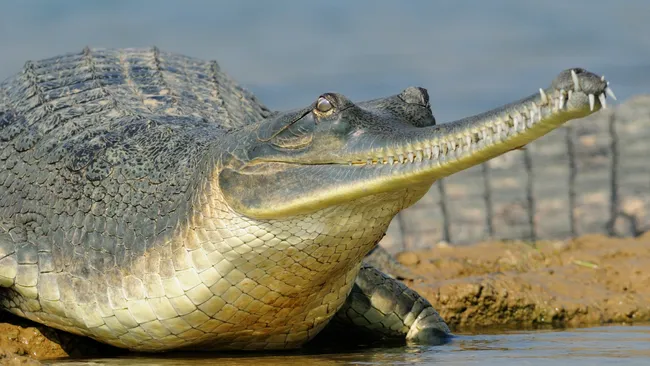This critically endangered animal, known for its long, thin snout with a bulbous growth at the end, split off from other crocodilian species 40 million years ago.
Name: Gharial (Gavialis gangeticus)
Habitat: Freshwater rivers in India and Nepal
Diet: Primarily fish; juveniles also consume insects, frogs, and crustaceans.
Why it’s Unique: Gharials stand out due to their exceptionally long, slender snouts, giving them a quirky appearance, almost as if it was flattened in an accident.
Adult male gharials have a distinctive “ghara” at the tip of their snout, a bulbous, pot-like shape that makes them more appealing to females. This feature helps males attract mates by producing bubbles and a unique vocalization—a buzzing, love song-like sound amplified by the ghara, which partially covers their nostrils, acting as a resonator, as noted by the Smithsonian’s National Zoo and Conservation Biology Institute.
If a male’s courtship efforts succeed, he’ll mate with one or more females, as gharials are polygamous. Mating generally occurs in December or January. When the dry season arrives in March or April, females lay about 40 eggs, which are among the largest crocodilian eggs, each weighing roughly 6 ounces (about 170 grams)—similar to a hockey puck. After an incubation period of 60 to 80 days, the young hatch and remain close to their mother for several weeks, or sometimes even months.
While they resemble other crocodilians, gharials diverged from their relatives over 40 million years ago. Unlike crocodiles and alligators that ambush prey, gharials use their slender snout to detect water vibrations by sweeping it from side to side, an effective method for catching fish with their interlocking teeth.
Well-suited to aquatic life, gharials are poorly adapted for moving on land due to their relatively weak leg muscles, so they belly-slide instead of walking.
Once numbering between 5,000 and 10,000 across regions from Pakistan to Myanmar in the 1940s, the gharial population has dwindled to around 650 mature individuals, mainly due to habitat loss, hunting, and fishing. However, conservation efforts, including captive breeding and nest monitoring, have slowly raised their numbers from a low of approximately 250 in 2006.
